Please wait...
About This Project
The Endangered Sri Lankan leopard is the second last remaining island leopard in the world. This unique sub species is threatened since Sri Lanka’s diminishing highly fragmented forest cover is its only refugium. Currently there is almost no information on how many leopards live in the island. This creates a strong need to assess its population. The Sri-Lankan Leopard Trust will carry out leopard population surveys in three of Sri Lanka's biggest National Parks: Yala, Wilpattu and Horton Plains
More Lab Notes From This Project

Browse Other Projects on Experiment
Related Projects
How do polar bears stay healthy on the world's worst diet?
Polar bears survive almost entirely on seal fat. Yet unlike humans who eat high-fat diets, polar bears never...
Uncovering hidden insect diversity associated with a likely undescribed gall-forming midge
Does a likely undescribed species of gall-forming midge (pers. comm. Ray Gagné) on Eriodictyon plants (Yerba...
Macrofungi of the California archipelago
The eight islands of the California Archipelago are a well-studied biodiversity hotspot — but we know almost...


